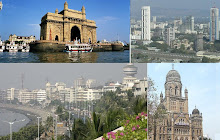

Gateway of India
The Gateway of India (Marathi: भारताचे प्रवेशद्वार) is a monument in Mumbai (formerly Bombay), India. Located on the waterfront in Apollo Bunder area in South Mumbai, the Gateway is a basalt arch 26 metres (85 ft) high. In earlier times, the Gateway was the monument that visitors arriving by boat would have first seen in the city of Bombay.[1]
The Gateway is built from yellow basalt and reinforced concrete. While its design is a combination of both Hindu and Muslim architectural styles, the Gateway of India is a symbol of Hinduism & Islam. Many of its elements are derived from the Muslim architectural styles of 16th century Gujarat. The pillars are derived from the design of Hindu temples and the design of the Gateway's windows comes from Muslim architecture.
The central dome is 15 metres (49 ft) in diameter and is 26 metres (85 ft) above ground at its highest point. The whole harbour front was realigned in order to come in line with a planned esplanade which would sweep down to the centre of the town. The cost of the construction was Rs. 21 lakhs (2,100,000), borne mainly by the Government of India. For lack of funds, the approach road was never built, and so the Gateway stands at an angle to the road leading up to it.
Contents
1 History
2 See also
3 References
4 External links
Gateway of India was built to commemorate the visit of King George V and Queen Mary to Bombay, prior to the Delhi Durbar, in December 1911. The foundation stone was laid on 31 March 1911, by the Governor of Bombay Sir George Sydenham Clarke, with the final design of George Wittet sanctioned in August 1914. Between 1915 and 1919 work proceeded on reclamations at Apollo Bundar for the land on which the gateway and the new sea wall would be built. The foundations were completed in 1920, and construction was finished in 1924. The Gateway was opened on 4 December 1924, by the Viceroy, the Earl of Reading.[1]
The last British troops to leave India, the First Battalion of the Somerset Light Infantry, passed through the Gateway in a ceremony on 28 February 1948.


No comments:
Post a Comment